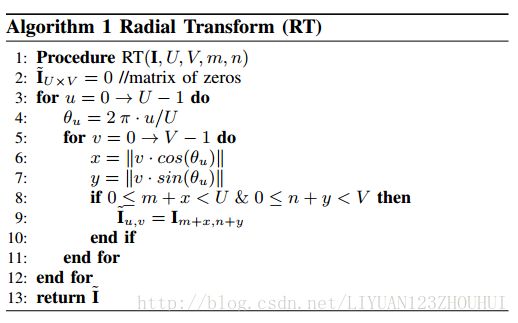Training Neural Networks with Very Little Data -- A Draft径向变换
最近有一篇针对数据增强的文章比较有意思:这里只讲一下核心的代码实现以及实现细节,原文可以自行查阅:
Training Neural Networks with Very Little Data – A Draft
文章的大概意思就是通过某种变换,将笛卡尔坐标系的图像通过坐标变换,变换成极坐标系下的图像,该变换直接通过下面的公式给出:

变换比较简单,公式也写的很清楚,根据公式实现的代码:
github:
https://github.com/zhly0/radial-transform
from skimage import data
from skimage import io
import numpy as np
import math
import matplotlib.pyplot as plt
def to_gray(img):
w, h,_ = img.shape
ret = np.empty((w, h), dtype=np.uint8)
retf = np.empty((w, h), dtype=np.float)
imgf = img.astype(float)
retf[:, :] = ((imgf[:, :, 1] + imgf[:, :, 2] + imgf[:, :, 0])/3)
ret = retf.astype(np.uint8)
return ret
def radia_transform(img,w,h):
shape = im.shape
new_im = np.zeros(shape)
print(shape)
print(len(shape))
print('w',w)
print('h',h)
width = shape[1]
height = shape[0]
lens = len(shape)
for i in range(0,width):
xita = 2*3.14159*i/width
for a in range(0,height):
x = (int)(math.floor(a * math.cos(xita)))
y = (int)(math.floor(a * math.sin(xita)))
new_y = (int)(h+x)
new_x = (int)(w+y)
#print(h.dtype)
if new_x>=0 and new_xif new_y>=0 and new_yif lens==3:
new_im[a,i,0] = (im[new_y,new_x,0]-127.5)/128
new_im[a,i,1] = (im[new_y,new_x,1]-127.5)/128
new_im[a,i,2] = (im[new_y,new_x,2]-127.5)/128
else:
new_im[a,i] = (im[new_y,new_x]-127.5)/128
new_im[a,i] = (im[new_y,new_x]-127.5)/128
new_im[a,i] = (im[new_y,new_x]-127.5)/128
return new_im
im = io.imread('E:/1.jpg')
im = to_gray(im)
h = im.shape[0]
w = im.shape[1]
new_im1 = radia_transform(im,(int)(w/2),(int)(h/2))
new_im2 = radia_transform(im,(int)(w/4),(int)(h/4))
new_im3 = radia_transform(im,(int)(w*0.5),(int)(h*0.75))
plt.figure(num='astronaut',figsize=(8,8))
plt.subplot(2,2,1)
plt.title('origin image')
plt.imshow(im,plt.cm.gray)
plt.subplot(2,2,2)
plt.title('0.5')
plt.imshow(new_im1,plt.cm.gray)
plt.axis('off')
plt.subplot(2,2,3)
plt.title('0.25')
plt.imshow(new_im2,plt.cm.gray)
plt.axis('off')
plt.subplot(2,2,4)
plt.title('0.75')
plt.imshow(new_im3,plt.cm.gray)
plt.axis('off')
plt.show() 